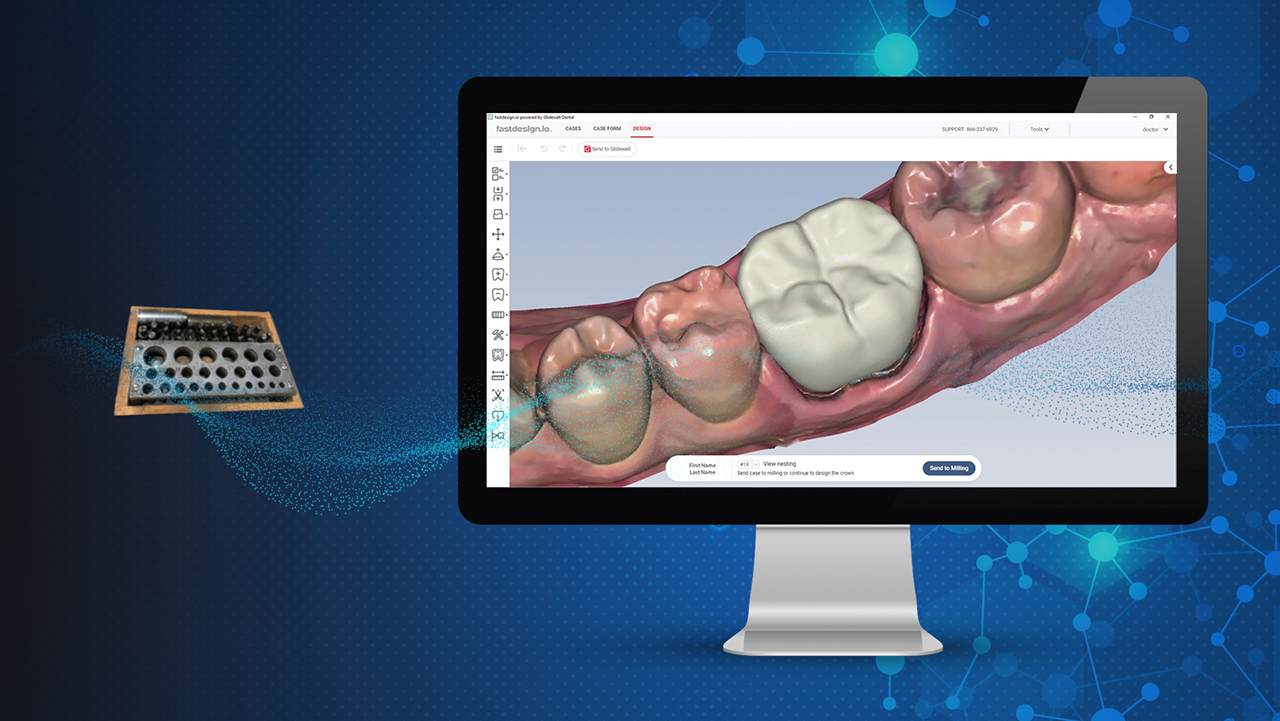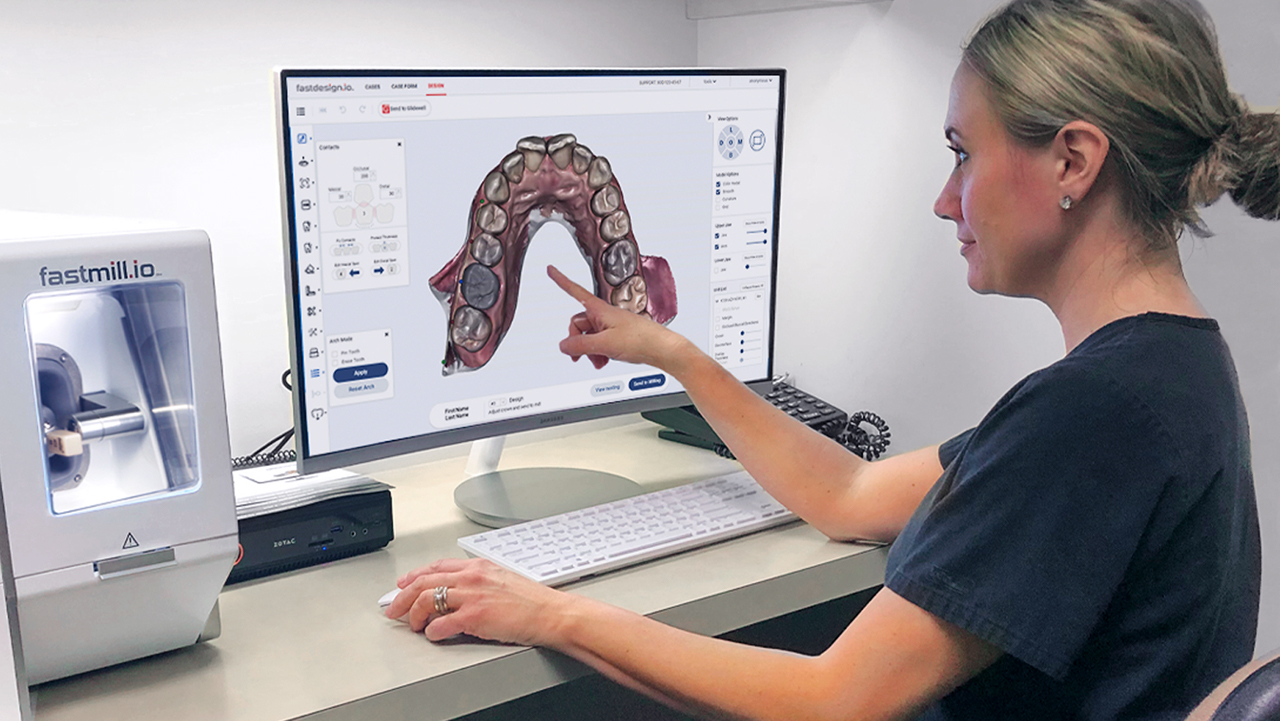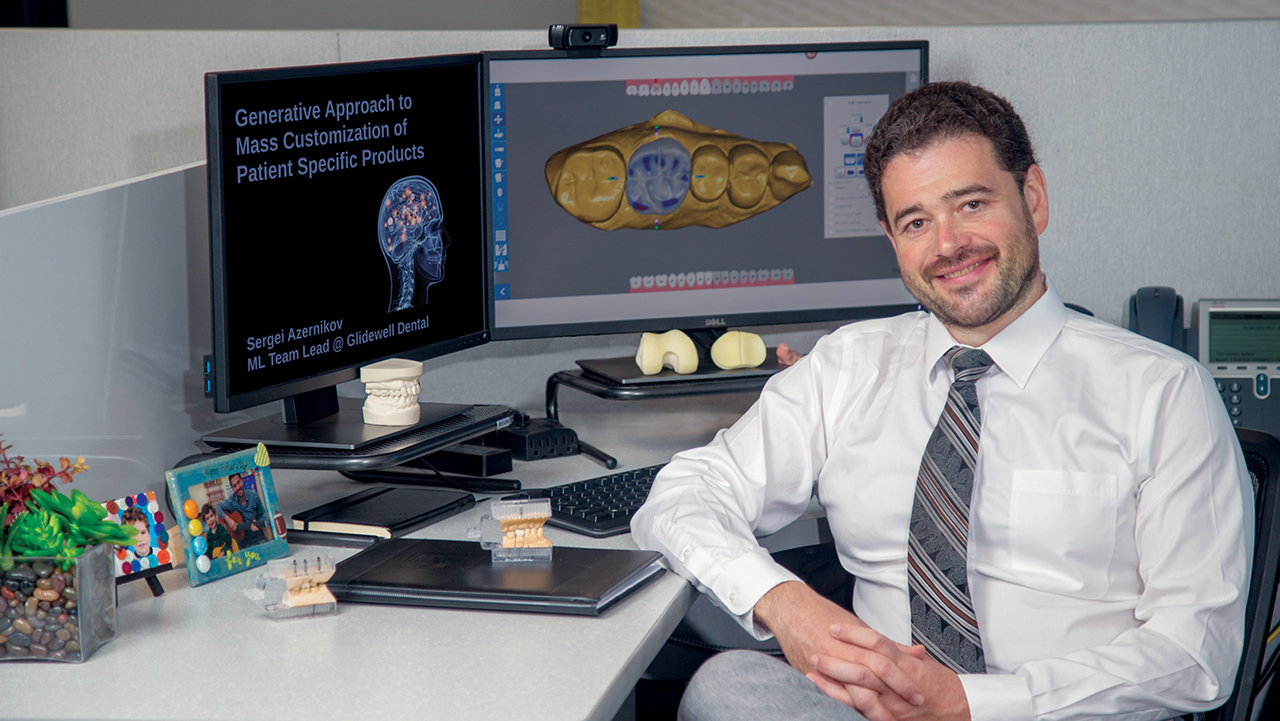2201 Dupont Dr., Irvine, CA 92612
© 2025 Glidewell. All rights reserved.
800-854-7256 USA
With glidewell.io™, you don’t need to be a lab tech. This system does the design work for you.

The development of crown design throughout the history of dentistry has paralleled the development of technology in general. From the early days of die-and-punch sets used to manually create crown shells, to the long-dominant process of highly trained technicians designing dental crowns & bridges that mimic natural teeth, these methodologies behind dental crowns have reflected their respective time periods. Now, as we move into an age where digital technology provides the underlying structure of so many real-world applications, crown design powered by machine learning and artificial intelligence (AI) algorithms has followed the curve.
Right now, there is no type of technology developing more quickly in the world of dentistry than that of AI, a pillar of CAD/CAM dentistry today. Specifically, AI technology is being applied to crown designs through the use of generative models, eliminating the need for technicians to undergo years of education in order to sculpt designs by hand so that they mimic actual teeth as closely as possible. Indeed, with the latest advances in AI crown design technology, it’s possible to create crowns via CAD/CAM dentistry that are more precise than what most skilled technicians could accomplish with the tools they are generally provided.

With the latest advances in AI crown design technology, it’s possible to create crowns that are more precise than ever before.
The key to successful AI crown design generation lies within the amount of information provided for the CAD/CAM dental technology. In order to create the most accurate designs possible, an AI algorithm must have a wide range of data to use when generating its models. This process, identified by the seemingly contradictive term “mass customization,” allows for the most detailed, suited-to-the-individual designs possible by providing the technology with many data points that can be relied upon for designs to suit nearly any situation.
Sergei Azernikov, Ph.D., of Glidewell, coauthored a research paper in conjunction with the University of California, Berkeley. The research describes how AI techniques produce advanced restorations designed to perfectly fit the patient’s dentition, provide ideal chewing function and exceed esthetic expectations. While the concept of applying AI knowledge and machine learning to dental restoration design is not unheard of, the algorithms that Glidewell uses are proprietary and available exclusively to Glidewell customers through the glidewell.io™ In-Office Solution. With the click of a button, glidewell.io users can access this CAD/CAM dental technology, prompting the chairside system to initiate its crown design process that utilizes years’ worth of data from the lab’s massive catalog of cases.

Sergei Azernikov, Ph.D., vice president of CAD/CAM software development at Glidewell, coauthored a research paper describing the use of AI techniques in the production of advanced dental restorations that are designed to fit patient dentition while providing ideal function.
Dating back to the earliest days of dentistry, the process of designing a crown has always started with taking an impression of the patient’s existing dentition. Doctors have been shifting from traditional impression methods that use vinyl polysiloxane (VPS) and trays to digital imaging wands and scanners for some time now, and CAD/CAM dental systems like glidewell.io are no exception. The submission of digital scans to fastdesign.io™, the proprietary software of the glidewell.io system, gives the computer the information it needs regarding the type of crown required to suit the indications at hand.
It is once the information is submitted into the software that the AI technology really takes over. In the past, it took dental technicians years of training to learn the skills required to create dental crowns. A skilled technician must be able to create not only a tooth that resembles the patient’s natural dentition and suits the situation at hand, but also one that meets “typical” standards for dentition such as cusp sizes, the functional requirements of the particular tooth in its particular position, and its esthetics. Each crown must then be customized while remaining “regular” so that it can both perform its function well and satisfy the needs of the particular patient being treated.
With AI technology, that learning curve loses its relevance. The fastdesign.io Software from Glidewell uses a fully automated approach that “learns” how to create crown designs not only by drawing from an immense library of information stored in the Glidewell database, but also from absorbing information about natural spatial profiles between opposing teeth. The use of a generative adversarial network (GAN) creates a basis upon which a deep learning model can predict the depth scan for the missing tooth, and thus create a crown to fill that space based upon not just the empty area but the opposing and surrounding dentition as well.
Azernikov and his collaborator at UC Berkeley, Jyh-Jing Hwang, have been recognized in the IT community for the advancements they’ve made in the field of AI through their work on the Glidewell crown design technology. As the future of AI and deep learning continues to develop, so too will the accuracy and ease of use for CAD/CAM dentistry. The incorporation of statistical data and ever-developing space constraints on the creation of crown designs within the software will result in ever-improving results that make doctors’ jobs easier while continuing to improve the treatment provided to patients.
Send blog-related questions and suggestions to hello@glidewell.com.


